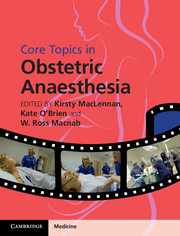Book contents
- Frontmatter
- Contents
- List of contributors
- Preface
- Section 1 Basic science, epidemiology and service organization
- Section 2 Obstetric aspects
- 5 Maternal critical care
- 6 Obstetrics for the anaesthetist
- 7 Antenatal assessment
- Section 3 Provision of anaesthesia
- Section 4 Medical conditions in pregnancy
- Section 5 Postpartum complications and obstetric emergencies
- Section 6 Service organization
- Index
- Plate section
- References
7 - Antenatal assessment
from Section 2 - Obstetric aspects
Published online by Cambridge University Press: 05 December 2015
- Frontmatter
- Contents
- List of contributors
- Preface
- Section 1 Basic science, epidemiology and service organization
- Section 2 Obstetric aspects
- 5 Maternal critical care
- 6 Obstetrics for the anaesthetist
- 7 Antenatal assessment
- Section 3 Provision of anaesthesia
- Section 4 Medical conditions in pregnancy
- Section 5 Postpartum complications and obstetric emergencies
- Section 6 Service organization
- Index
- Plate section
- References
Summary
In 2007 the Department of Health published Maternity Matters: Choice, Access and Continuity of Care in a Safe Service. The over-riding aim of any maternity service is to provide safe, high-quality care to women and their partners, thus enabling a safe pregnancy and birth for both mother and baby and to provide a confident start to family life.
For the majority of women, midwives and obstetricians will deliver care, but there are an increasing number of women whose pregnancy, labour or delivery require anaesthetic input.
Over the past decade the Centre for Maternal and Child Enquiries (CMACE), the Royal College of Obstetricians and Gynaecologists (RCOG), the Obstetric Anaesthetists’ Association (OAA) and the Association of Anaesthetists of Great Britain and Ireland (AAGBI) have all produced guidance emphasizing the need for good communication between all the speciality groups providing antenatal care. Antenatal anaesthetic assessment is pivotal in planning peripartum care, particularly for those with co-existing disease, to ensure the best outcome for these women. The most recent guidance from the OAA/AAGBI states there should be an agreed system whereby the anaesthetist is given sufficient notice of all potentially high-risk patients. In the majority of obstetric units this would be done as a referral to an antenatal anaesthetic assessment clinic.
Antenatal anaesthetic clinic
There are increasing numbers of parturients presenting with co-existing, complex medical conditions. This may, in part, result from the advances in medicine that have rendered such conditions more stable and have seen these women surviving to childbearing age. Many women are now choosing to have children later in life, resulting in an increase in acquired co-morbidity. The prevalence of morbid obesity has significantly increased in the UK (1.4% in 1993, 2.9% in 2005). This was echoed by data published by the World Health Organization, demonstrating that the prevalence of obesity has nearly doubled between 1998 and 2008.
The anaesthetic service not only provides intrapartum analgesia and anaesthesia, but also assists in the delivery of peripartum care to women with complications related to their pregnancy or co-existing medical disease.
The aim of the antenatal clinic is to carry out a review of the woman's history, assess the impact of any co-morbidities and provide information. The outcome of the visit should be an individualized anaesthetic management plan for labour and delivery.
- Type
- Chapter
- Information
- Core Topics in Obstetric Anaesthesia , pp. 44 - 48Publisher: Cambridge University PressPrint publication year: 2015



